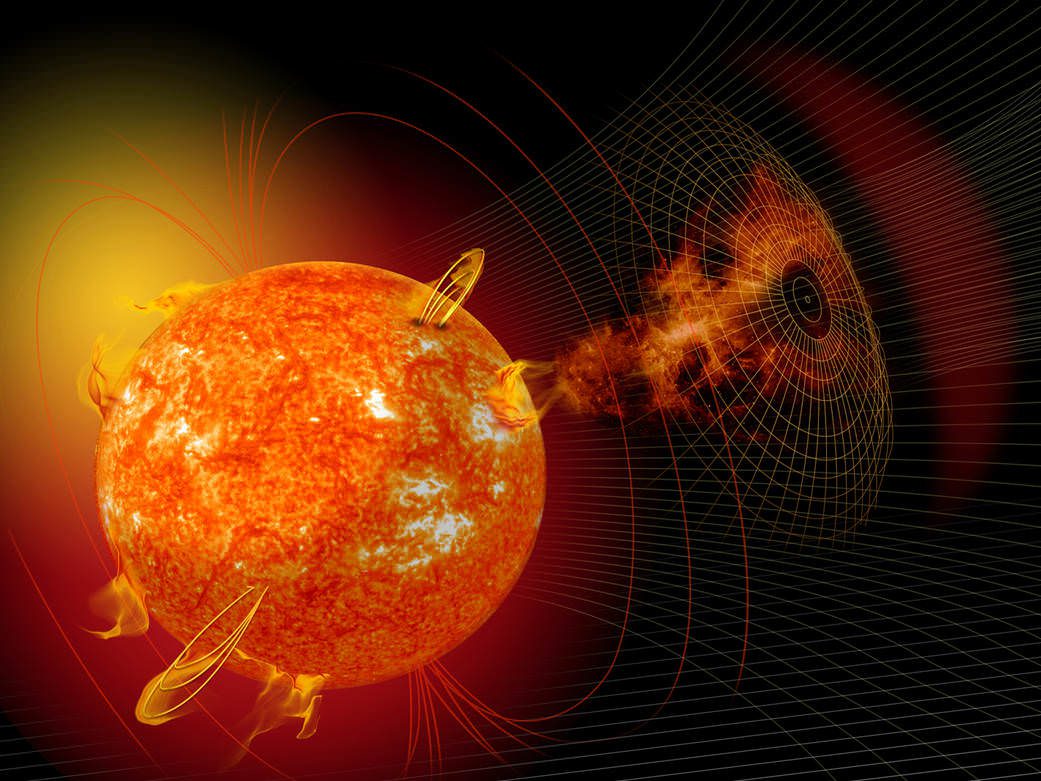Could an electrical pandemic destroy shipping?
by John Konrad (gCaptain) As China's lockdown lifts and the world looks to the future with the hope that this marks the final chapter in the worst pandemic since the great flu of 1918, it It is essential to remember that other catastrophic events could bring world trade to a screeching halt again in this most unlucky decade. COVID has been a devastating reminder of the fragility of human life, and history tells us that a great naval war still looms on the horizon, but what if a computer virus could wreak the same havoc? It may seem like overkill, but it's not impossible. While extensive network security protocols would likely stop the spread of a man-made virus, history reminds us of a natural electromagnetic threat that could be just as deadly to machines as COVID was to human lives.
On the unforgettable day of September 2, 1859, British astronomer Richard Carrington made a remarkable discovery: a larger white flare on the sun. His sighting of the first coronal mass ejection (CME) was confirmed by others and soon after the mesmerizing aurora plunged down to Cuba. But the event brought more than heavenly beauty. This phenomenon had a remarkable effect on telegraph wires - the most advanced technology of the time. In the United States and Europe, malfunctions caused communications chaos and sparked wildfires. It was a remarkable event that wreaked manageable havoc mainly because it happened nearly two decades before telephones and 23 years before the first centralized commercial generation of electricity
A CME is a colossal eruption of solar material and magnetic fields that is unleashed from the solar atmosphere. It is made up of billions of tons of plasma and magnetic fields rushing at speeds of up to several million kilometers per hour. When CMEs conflict with the Earth's magnetic field, they can cause geomagnetic storms that can wreak havoc on power grids, satellite communications, and even ship navigation systems.
Related book: How the World Really Works: The Science Behind How We Got Here and Where We're Going by Vaclav Smil
“Even limited damage would mean hours or days of disruption to communications and network operations,” wrote Vaclav Smil in his 2022 book How The World Really Works. "A massive geomagnetic storm would sever all of these links on a global scale... Estimates of global damage differ by an order of magnitude, from $2 trillion to $20 trillion, but that only refers to to the expense, not the value of lives lost over extended periods of time without communication, lights, air conditioning, hospital equipment, refrigeration and industrial production.”
The Mega CME 2012The most recent mega-CME occurred in 2012 and was so powerful it was visible from Earth as a bright lightning bolt in the sky. It has also been detected by several spacecraft, including NASA's Solar Dynamics Observatory and the Solar and Heliospheric Observatory. The CME was estimated to be approximately 10 times larger than any other CME ever recorded by modern equipment and is considered comparable to the Carrington event.
But the 2012 CME didn't destroy any satellites or damage much electrical equipment around the world. Why? Sunspots are very directional and depend on the location of the sun and where the ejection occurs on the giant mass. The 2012 CME was not pointed at us, and the sun's slow rotation period of about 25 days caused the electromagnetic beam to miss Earth by a margin of about nine days.
WEC 2012 was an awesome event, and it's a reminder of the power of the sun. CMEs can significantly disrupt our technology, and it's important to be prepared. Scientists continue to study EMFs to better understand their behavior and develop ways to mitigate their effects, but there may not be much we can do to prevent mass chaos because modern electrical devices are not not designed to survive billions of tons of solar expulsions. explosively pointed straight at the ground.
Today we are far more vulnerable than Carrington's contemporaries were in 1859 and only slightly more prepared than we were...

by John Konrad (gCaptain) As China's lockdown lifts and the world looks to the future with the hope that this marks the final chapter in the worst pandemic since the great flu of 1918, it It is essential to remember that other catastrophic events could bring world trade to a screeching halt again in this most unlucky decade. COVID has been a devastating reminder of the fragility of human life, and history tells us that a great naval war still looms on the horizon, but what if a computer virus could wreak the same havoc? It may seem like overkill, but it's not impossible. While extensive network security protocols would likely stop the spread of a man-made virus, history reminds us of a natural electromagnetic threat that could be just as deadly to machines as COVID was to human lives.
On the unforgettable day of September 2, 1859, British astronomer Richard Carrington made a remarkable discovery: a larger white flare on the sun. His sighting of the first coronal mass ejection (CME) was confirmed by others and soon after the mesmerizing aurora plunged down to Cuba. But the event brought more than heavenly beauty. This phenomenon had a remarkable effect on telegraph wires - the most advanced technology of the time. In the United States and Europe, malfunctions caused communications chaos and sparked wildfires. It was a remarkable event that wreaked manageable havoc mainly because it happened nearly two decades before telephones and 23 years before the first centralized commercial generation of electricity
A CME is a colossal eruption of solar material and magnetic fields that is unleashed from the solar atmosphere. It is made up of billions of tons of plasma and magnetic fields rushing at speeds of up to several million kilometers per hour. When CMEs conflict with the Earth's magnetic field, they can cause geomagnetic storms that can wreak havoc on power grids, satellite communications, and even ship navigation systems.
Related book: How the World Really Works: The Science Behind How We Got Here and Where We're Going by Vaclav Smil
“Even limited damage would mean hours or days of disruption to communications and network operations,” wrote Vaclav Smil in his 2022 book How The World Really Works. "A massive geomagnetic storm would sever all of these links on a global scale... Estimates of global damage differ by an order of magnitude, from $2 trillion to $20 trillion, but that only refers to to the expense, not the value of lives lost over extended periods of time without communication, lights, air conditioning, hospital equipment, refrigeration and industrial production.”
The Mega CME 2012The most recent mega-CME occurred in 2012 and was so powerful it was visible from Earth as a bright lightning bolt in the sky. It has also been detected by several spacecraft, including NASA's Solar Dynamics Observatory and the Solar and Heliospheric Observatory. The CME was estimated to be approximately 10 times larger than any other CME ever recorded by modern equipment and is considered comparable to the Carrington event.
But the 2012 CME didn't destroy any satellites or damage much electrical equipment around the world. Why? Sunspots are very directional and depend on the location of the sun and where the ejection occurs on the giant mass. The 2012 CME was not pointed at us, and the sun's slow rotation period of about 25 days caused the electromagnetic beam to miss Earth by a margin of about nine days.
WEC 2012 was an awesome event, and it's a reminder of the power of the sun. CMEs can significantly disrupt our technology, and it's important to be prepared. Scientists continue to study EMFs to better understand their behavior and develop ways to mitigate their effects, but there may not be much we can do to prevent mass chaos because modern electrical devices are not not designed to survive billions of tons of solar expulsions. explosively pointed straight at the ground.
Today we are far more vulnerable than Carrington's contemporaries were in 1859 and only slightly more prepared than we were...
What's Your Reaction?














![Three of ID's top PR executives quit ad firm Powerhouse [EXCLUSIVE]](https://variety.com/wp-content/uploads/2023/02/ID-PR-Logo.jpg?#)







